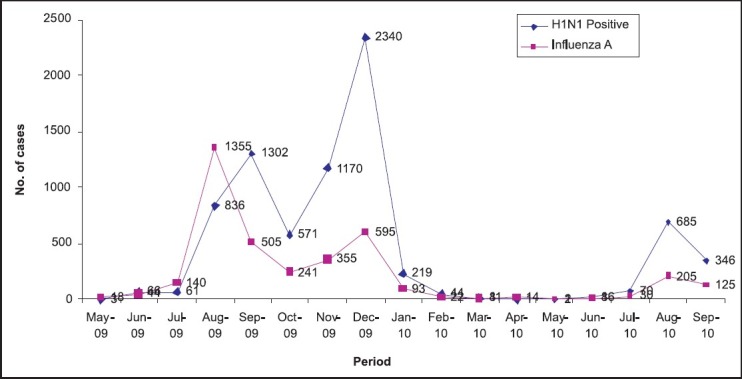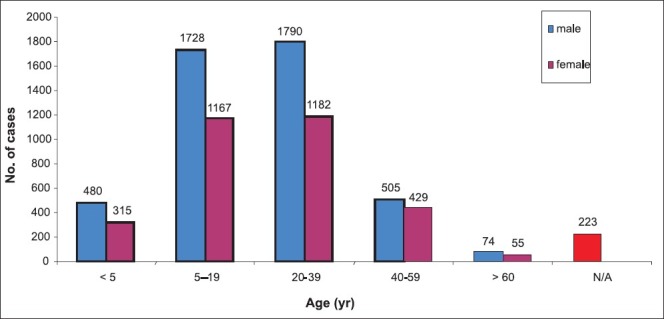Abstract
Background & objectives:
Pandemic H1N1 caused deluge of cases from 74 countries and prompted World Health Organization to raise warning to phase 6. The present study was conducted on throat and nasal swab samples received and tested at National Centre for Disease Control, Delhi, India during 2009-2010 to collect epidemiological and clinical information on positive cases.
Methods:
Throat and nasopharyngeal swabs from category C influenza A H1N1 patients during May 2009-September 2010 along with their clinico-epidemiological details were collected from identified hospitals from Delhi and other States. Samples were tested by Real time reverse transcriptase PCR using primers and probes developed at CDC, Atlanta for four influenza target genes.
Results:
A total of 33,751 samples, both throat and nasal swab samples from each patient were tested for H1N1 influenza virus, of which, 7943 (23.5%) were positive for pandemic influenza A H1N1 and 3759 (11.1%) were positive for influenza A (seasonal flu). Maximum number of positive cases (N=2792, 35.1%) were from 20-39 yr age group, comprising 1790 (22.5%) males and 1182 (14.8%) females. Only 2620 (33%) positive cases were close contact of influenza A H1N1 positive patient. Majority cases presented (N=2792, 35.1%) with fever 7005 (88.1%), followed by 6133 cases (77.2%) exhibiting fever and cough, 377 (4.7%) complained of fever, cough, nasal catarrh and 362 (4.5%) cases had fever with shortness of breath.
Interpretation & conclusions:
The study showed a peak of cases of pandemic influenza A H1N1 in December 2009 and indicated predominance of H1N1 positive cases among 20-39 yr age group and among males compared to females.
Keywords: H1N1, influenza A, pandemic, seasonal influenza
Respiratory illnesses due to influenza virus infection are a major cause of morbidity and mortality worldwide. Lower respiratory tract infections are a leading cause of deaths in developing countries and are also the third leading cause of death worldwide. Globally influenza is responsible for 250,000 to 500,000 deaths annually1.
In April 2009, the first case of influenza A H1N1 was reported from Mexico2. Subsequently, the infection led to spread of disease across 74 countries with 30, 000 confirmed cases on June 11, 2009. This prompted the World Health Organization to raise the warning from phase 5 to phase 63. A total of 214 countries were affected by the pandemic worldwide.
In India, the first case of influenza A H1N1 was reported on May 16, 2009 from Hyderabad4. The World Health Organization declared the post pandemic phase on August 10, 20105. Subsequently, the influenza activity in the six regions of the world has declined6. The Central and State governments in India had taken the pandemic very seriously and made several unprecedented and innovative interventions including the pandemic preparedness plan7. In view of lack of epidemiological information on pandemic influenza A H1N1 from India, the present study was conducted on samples received and tested at National Centre for Disease Control (NCDC), Delhi, India during 2009-2010.
Material & Methods
The National Centre for Disease Control (NCDC), Delhi, India, is an apex public health institution and during the H1N1 pandemic 2009-2010, it was declared as the nodal agency for testing of samples of H1N1 from all over the country. This study was a retrospective analysis of the clinical epidemiological information consisting of clinical presentations, history of contact among H1N1 positive persons and positivity rate of different types of influenza viruses in these samples.
Throat and nasal swabs were collected (during May 2009 - September 2010) from 11 designated government hospitals in Delhi and many different States of the country and tested for influenza A H1N1. As per the Ministry of Health & Family Welfare (MOHFW) guidelines on categorization of H1N1 cases8, only category C patients were subjected to testing for H1N1. Although all patients included in the study were categorized as category C, but none of the patients complained of somnolence, inability to feed well, convulsions, or worsening of underlying chronic conditions during admission.
A total of 33,751 throat swabs and nasal swabs/nasopharyngeal swabs were collected by clinicians in viral transport medium (VTM) from category C patients, and sent to NCDC under triple packaging cold chain conditions from different parts of the country including Delhi. Samples were accompanied with duly filled proforma indicating demographic characteristics, date of onset of symptoms, co-morbidities, travel/contact history, antiviral treatment, etc. These samples were processed in Bio Safety level 3 (BSL 3) laboratory within 2-3 h of receipt of sample. RNA extraction from the samples was done using QI Amp ® viral RNA Mini Kit or RNeasy® Mini kit from Qiagen, USA. Reverse transcription and amplification of the target genes was carried out using CDC Real Time RT PCR kit protocol. In each sample four target genes were amplified; Influenza A, Swine Influenza A, Swine H1 and RNaseP (CDC Real Time RT PCR kit). A sample was declared positive when it showed amplification in all 4 target genes.
Results
A total of 33,751 persons were tested for H1N1, of whom 7,943 (23.5%) were positive for pandemic influenza A H1N1 and 3,759 (11.1%) were positive for influenza A (seasonal flu).
The cases of both pandemic influenza A H1N1 and influenza A started rising from July 2009 with maximum number of cases (n=2340) of H1N1 positive cases in December 2009. Seasonal influenza exhibited surge in August 2009 and August 2010 (Fig. 1). Maximum number of influenza A H1N1 positives cases seen in the age group of 20-39 yr, followed by 5-19 yr (Fig. 2).
Fig. 1.

Monthly trend of pandemic influenza A H1N1 and seasonal flu reported from May 2009 to September 2010.
Fig. 2.

Age and sex distribution of the influenza A H1N1 2009 positive cases. Males were affected more than females.
Contact history was also elicited and it was observed that 2630 (25%) positive H1N1 cases had close contact with laboratory confirmed cases of influenza A H1N1. A total of 7005 (88.1%) cases presented with fever alone and 6133 (77.2%) had fever with cough, 4.7 per cent (n=377) had fever with cough and nasal catarrh and 362 (4.5%) reported fever with shortness of breath. Some pandemic influenza A H1N1 positive patients presented with unusual symptoms like diarrhoea (n=1), vomiting (n=6), body ache (n=5) and headache (n=9).
Discussion
Majority of the positive cases of 2009 pandemic influenza A H1N1 virus presented with acute and self-limited infection, with the highest attack rates reported among children and young adults. Similar study from Vietnam showed difference in the positivity rate of influenza A H1N1 with total positivity of 2.5 per cent as compared to 23.5 per cent in our study9. Another study from England suggested the total positivity to be 7 per cent10. Our study had samples mainly belonging to category C. A study conducted by Chilean Task Force for study of Pandemic Influenza A (H1N1) reported the total positivity of influenza A H1N1 to be 62.79 per cent and for seasonal influenza 36.15 per cent, which was very high compared with our data11. The differences could be attributed to the categorization of cases.
Our results on seasonality were in variance with the report from Vietnam and England9,10. These studies reported two peaks for both influenza A H1N1 and influenza A (seasonal flu), one in summer and another one in winter. These differences could probably be due to change in the geographical and climatic conditions.
In our study, maximum positive cases were found in the age group of 20-39 yr and males were affected more than females. Similar study conducted in north India had variance in the affected age group with majority affected in the age group of 1-5 yr. The variance might be due to inclusion of only paediatric patients in the study12. Gurav et al13 in their study conducted in Maharashtra reported the most affected age group as 20-39 yr similar to our study.
Fever was the commonest clinical feature of the positive cases in our study similar to other studies from India14,15. Adults were affected more and positive cases were reported more in males than in females. High positivity was reported among close contacts15. Broor et al15 found a high prevalence of pandemic H1N1 and influenza A with bimodal peaks in weeks 39 and 48. The risk group that was highly vulnerable to the virus comprised school-going children (5-18 yr). A study from Chennai reported that the peak influenza activity occurred in June coinciding with onset of Northwest monsoon16.
In conclusion, our results showed that the pandemic influenza A H1N1 and seasonal influenza A that occurred during 2009-2010 in India was of moderate severity in terms of positivity rate when compared with other countries. Our results also indicated predominance of pandemic 2009 influenza A H1N1 positive cases during winter seasons and those of seasonal flu in the rainy season.
Acknowledgment
Authors acknowledge all the staff of Microbiology Division of NCDC and Disease Outbreak Monitoring Cell, with special thanks to Shrimati Inderjeet for her support in testing of samples. Authors also acknowledge Centre for Disease Control (CDC), Atlanta for supply of reagents, technical support and training.
References
- 1.Influenza (Seasonal), World Health Organization. 2009. Apr, [accessed on April 16, 2012]. Available from: http://www.who.int/mediacentre/factsheets/fs211/en/
- 2.Update: Novel influenza A (H1N1) virus infection Mexico. March-May, 2009. CDC Morbidity and Mortality Weekly Report. 2009 Jun 5;58:585–9. [PMC free article] [PubMed] [Google Scholar]
- 3.World Health Organization. World now at the start of 2009 influenza pandemic. Statement to the press by WHO Director General - Dr Margaret Chan. [accessed on November 18, 2011]. Available from: http://www.who.int/mediacentre/news/statements/2009/h1n1_pandemic_phase6_20090611/en/index.html .
- 4.Ministry of Health and Family Welfare, India. Information on Swine Flu. New Delhi: MOHFW; [accessed on November 18, 2011]. Available from: http:// www.mohfw.nic.in/swineflu.htm . [Google Scholar]
- 5.World Health Organization. H1N1 in post pandemic period. [accessed on November 18, 2011]. Available from: http://www.who.int/mediacentre/news/statements/2010/h1n1_vpc_20100810/en/index.html .
- 6.World Health Organization. Influenza updates. [accessed on November 18, 2011]. Available from: http://www.who.int/influenza/surveillance_monitoring/updates/en/index.html .
- 7.John TH, Moorthy M. 2009 Pandemic influenza in India. Indian Paediatr. 2010;47:25–31. doi: 10.1007/s13312-010-0007-4. [DOI] [PMC free article] [PubMed] [Google Scholar]
- 8.New Delhi: MOHFW; [accessed on April 20, 2010]. Ministry of Health and Family Welfare, India. Information on Swine Flu. Available from: http://mohfw-h1n1.nic.in/documents/pdf/3.categorizationofinfluenzah1n1casesscreenting.pdf . [Google Scholar]
- 9.Nguyen HL, Saito R, Ngiem HK, Nishikawa M, Shobugawa Y, Nguyen DC, et al. Epidemiology of influenza in Hanoi, Vietnam. J Infect. 2007;55:58–63. doi: 10.1016/j.jinf.2006.12.001. [DOI] [PubMed] [Google Scholar]
- 10.Elliot AJ, Powers C, Thornton A, Obi C, Hill C, Simms I, et al. Monitoring the emergence of community transmission of influenza A/H1N1 2009 in England: a cross sectional opportunistic survey of self sampled telephone callers to NHS Direct. BMJ Infect Dis. 2009;339:3403. doi: 10.1136/bmj.b3403. [DOI] [PMC free article] [PubMed] [Google Scholar]
- 11.Pedroni García EM, Espínola V, Guerrero A, González C, Olea A, Calvo M, et al. Chilean Task Force for study of Pandemic Influenza A (H1N1) Outbreak of 2009 pandemic influenza A(H1N1), Los Lagos, Chile, April-June 2009. Eurosurveillance. 2010;15 doi: 10.2807/ese.15.01.19456-en. [DOI] [PubMed] [Google Scholar]
- 12.Parakh A, Kumar A, Kumar V, Dutta AK, Khare S. Pediatric hospitalizations associated with 2009 pandemic influenza A (H1N1): An experience from a tertiary care center in north India. Indian J Pediatr. 2010;77:981–5. doi: 10.1007/s12098-010-0168-0. [DOI] [PMC free article] [PubMed] [Google Scholar]
- 13.Gurav YK, Pawar SD, Chadha MS, Potdar VA, Deshpande AS, Koratkar SS, et al. Pandemic influenza A(H1N1) 2009 outbreak in a residential school at Panchgani, Maharashtra, India. Indian J Med Res. 2010;132:67–71. [PubMed] [Google Scholar]
- 14.Kaji M, Watanabe A, Aizawa H. Differences in clinical features between Influenza A H1N1, A H3N2, and B in adult patients. Respirology. 2003;8:231–3. doi: 10.1046/j.1440-1843.2003.00457.x. [DOI] [PubMed] [Google Scholar]
- 15.Broor S, Gupta S, Mohapatra S, Kaushik S, Mir MA, Jain P, et al. Emergence of 2009A/H1N1 cases in a tertiary care hospital in New Delhi, India. Influenza Other Respi Viruses. 2011;5:e552–7. doi: 10.1111/j.1750-2659.2011.00274.x. [DOI] [PMC free article] [PubMed] [Google Scholar]
- 16.Ramamurty N, Pillai LC, Gunasekaran P, Elango V, Mohana, Priya P, et al. Influenza activity among the pediatric age group in Chennai. Indian J Med Res. 2005;121:776–9. [PubMed] [Google Scholar]


